Wolfgang Nejdl
MedAI: Evaluating TxAgent's Therapeutic Agentic Reasoning in the NeurIPS CURE-Bench Competition
Dec 12, 2025Abstract:Therapeutic decision-making in clinical medicine constitutes a high-stakes domain in which AI guidance interacts with complex interactions among patient characteristics, disease processes, and pharmacological agents. Tasks such as drug recommendation, treatment planning, and adverse-effect prediction demand robust, multi-step reasoning grounded in reliable biomedical knowledge. Agentic AI methods, exemplified by TxAgent, address these challenges through iterative retrieval-augmented generation (RAG). TxAgent employs a fine-tuned Llama-3.1-8B model that dynamically generates and executes function calls to a unified biomedical tool suite (ToolUniverse), integrating FDA Drug API, OpenTargets, and Monarch resources to ensure access to current therapeutic information. In contrast to general-purpose RAG systems, medical applications impose stringent safety constraints, rendering the accuracy of both the reasoning trace and the sequence of tool invocations critical. These considerations motivate evaluation protocols treating token-level reasoning and tool-usage behaviors as explicit supervision signals. This work presents insights derived from our participation in the CURE-Bench NeurIPS 2025 Challenge, which benchmarks therapeutic-reasoning systems using metrics that assess correctness, tool utilization, and reasoning quality. We analyze how retrieval quality for function (tool) calls influences overall model performance and demonstrate performance gains achieved through improved tool-retrieval strategies. Our work was awarded the Excellence Award in Open Science. Complete information can be found at https://curebench.ai/.
Towards Transparent Stance Detection: A Zero-Shot Approach Using Implicit and Explicit Interpretability
Nov 05, 2025Abstract:Zero-Shot Stance Detection (ZSSD) identifies the attitude of the post toward unseen targets. Existing research using contrastive, meta-learning, or data augmentation suffers from generalizability issues or lack of coherence between text and target. Recent works leveraging large language models (LLMs) for ZSSD focus either on improving unseen target-specific knowledge or generating explanations for stance analysis. However, most of these works are limited by their over-reliance on explicit reasoning, provide coarse explanations that lack nuance, and do not explicitly model the reasoning process, making it difficult to interpret the model's predictions. To address these issues, in our study, we develop a novel interpretable ZSSD framework, IRIS. We provide an interpretable understanding of the attitude of the input towards the target implicitly based on sequences within the text (implicit rationales) and explicitly based on linguistic measures (explicit rationales). IRIS considers stance detection as an information retrieval ranking task, understanding the relevance of implicit rationales for different stances to guide the model towards correct predictions without requiring the ground-truth of rationales, thus providing inherent interpretability. In addition, explicit rationales based on communicative features help decode the emotional and cognitive dimensions of stance, offering an interpretable understanding of the author's attitude towards the given target. Extensive experiments on the benchmark datasets of VAST, EZ-STANCE, P-Stance, and RFD using 50%, 30%, and even 10% training data prove the generalizability of our model, benefiting from the proposed architecture and interpretable design.
Tokenization Disparities as Infrastructure Bias: How Subword Systems Create Inequities in LLM Access and Efficiency
Oct 14, 2025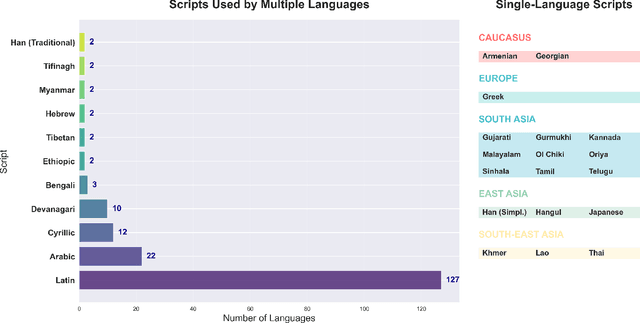
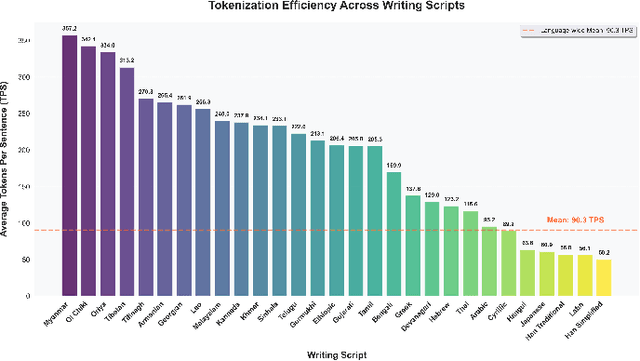
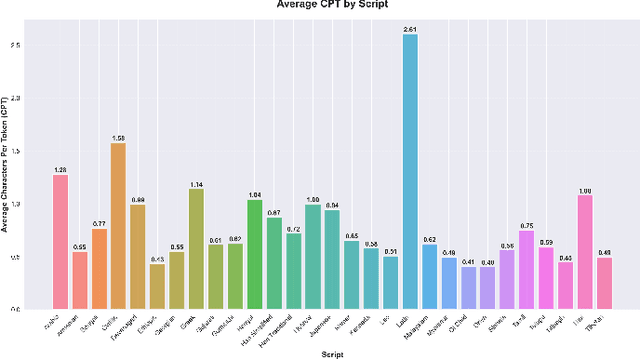
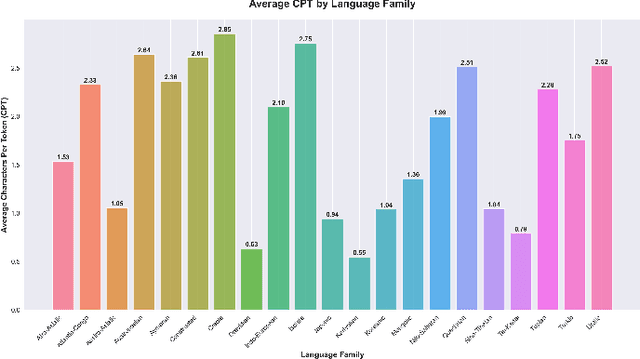
Abstract:Tokenization disparities pose a significant barrier to achieving equitable access to artificial intelligence across linguistically diverse populations. This study conducts a large-scale cross-linguistic evaluation of tokenization efficiency in over 200 languages to systematically quantify computational inequities in large language models (LLMs). Using a standardized experimental framework, we applied consistent preprocessing and normalization protocols, followed by uniform tokenization through the tiktoken library across all language samples. Comprehensive tokenization statistics were collected using established evaluation metrics, including Tokens Per Sentence (TPS) and Relative Tokenization Cost (RTC), benchmarked against English baselines. Our cross-linguistic analysis reveals substantial and systematic disparities: Latin-script languages consistently exhibit higher tokenization efficiency, while non-Latin and morphologically complex languages incur significantly greater token inflation, often 3-5 times higher RTC ratios. These inefficiencies translate into increased computational costs and reduced effective context utilization for underrepresented languages. Overall, the findings highlight structural inequities in current AI systems, where speakers of low-resource and non-Latin languages face disproportionate computational disadvantages. Future research should prioritize the development of linguistically informed tokenization strategies and adaptive vocabulary construction methods that incorporate typological diversity, ensuring more inclusive and computationally equitable multilingual AI systems.
MoVoC: Morphology-Aware Subword Construction for Geez Script Languages
Sep 10, 2025



Abstract:Subword-based tokenization methods often fail to preserve morphological boundaries, a limitation especially pronounced in low-resource, morphologically complex languages such as those written in the Geez script. To address this, we present MoVoC (Morpheme-aware Subword Vocabulary Construction) and train MoVoC-Tok, a tokenizer that integrates supervised morphological analysis into the subword vocabulary. This hybrid segmentation approach combines morpheme-based and Byte Pair Encoding (BPE) tokens to preserve morphological integrity while maintaining lexical meaning. To tackle resource scarcity, we curate and release manually annotated morpheme data for four Geez script languages and a morpheme-aware vocabulary for two of them. While the proposed tokenization method does not lead to significant gains in automatic translation quality, we observe consistent improvements in intrinsic metrics, MorphoScore, and Boundary Precision, highlighting the value of morphology-aware segmentation in enhancing linguistic fidelity and token efficiency. Our morpheme-annotated datasets and tokenizer will be publicly available to support further research in low-resource, morphologically rich languages. Our code and data are available on GitHub: https://github.com/hailaykidu/MoVoC
"Where does it hurt?" -- Dataset and Study on Physician Intent Trajectories in Doctor Patient Dialogues
Aug 26, 2025Abstract:In a doctor-patient dialogue, the primary objective of physicians is to diagnose patients and propose a treatment plan. Medical doctors guide these conversations through targeted questioning to efficiently gather the information required to provide the best possible outcomes for patients. To the best of our knowledge, this is the first work that studies physician intent trajectories in doctor-patient dialogues. We use the `Ambient Clinical Intelligence Benchmark' (Aci-bench) dataset for our study. We collaborate with medical professionals to develop a fine-grained taxonomy of physician intents based on the SOAP framework (Subjective, Objective, Assessment, and Plan). We then conduct a large-scale annotation effort to label over 5000 doctor-patient turns with the help of a large number of medical experts recruited using Prolific, a popular crowd-sourcing platform. This large labeled dataset is an important resource contribution that we use for benchmarking the state-of-the-art generative and encoder models for medical intent classification tasks. Our findings show that our models understand the general structure of medical dialogues with high accuracy, but often fail to identify transitions between SOAP categories. We also report for the first time common trajectories in medical dialogue structures that provide valuable insights for designing `differential diagnosis' systems. Finally, we extensively study the impact of intent filtering for medical dialogue summarization and observe a significant boost in performance. We make the codes and data, including annotation guidelines, publicly available at https://github.com/DATEXIS/medical-intent-classification.
FlexTSF: A Universal Forecasting Model for Time Series with Variable Regularities
Oct 30, 2024Abstract:Developing a foundation model for time series forecasting across diverse domains has attracted significant attention in recent years. Existing works typically assume regularly sampled, well-structured data, limiting their applicability to more generalized scenarios where time series often contain missing values, unequal sequence lengths, and irregular time intervals between measurements. To cover diverse domains and handle variable regularities, we propose FlexTSF, a universal time series forecasting model that possesses better generalization and natively support both regular and irregular time series. FlexTSF produces forecasts in an autoregressive manner and incorporates three novel designs: VT-Norm, a normalization strategy to ablate data domain barriers, IVP Patcher, a patching module to learn representations from flexibly structured time series, and LED attention, an attention mechanism to seamlessly integrate these two and propagate forecasts with awareness of domain and time information. Experiments on 12 datasets show that FlexTSF outperforms state-of-the-art forecasting models respectively designed for regular and irregular time series. Furthermore, after self-supervised pre-training, FlexTSF shows exceptional performance in both zero-shot and few-show settings for time series forecasting.
Towards Precision Healthcare: Robust Fusion of Time Series and Image Data
May 24, 2024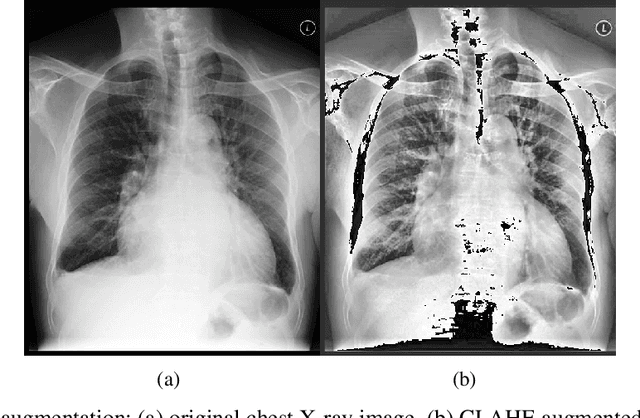

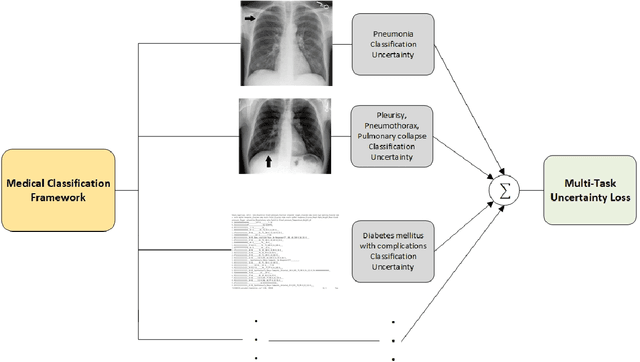
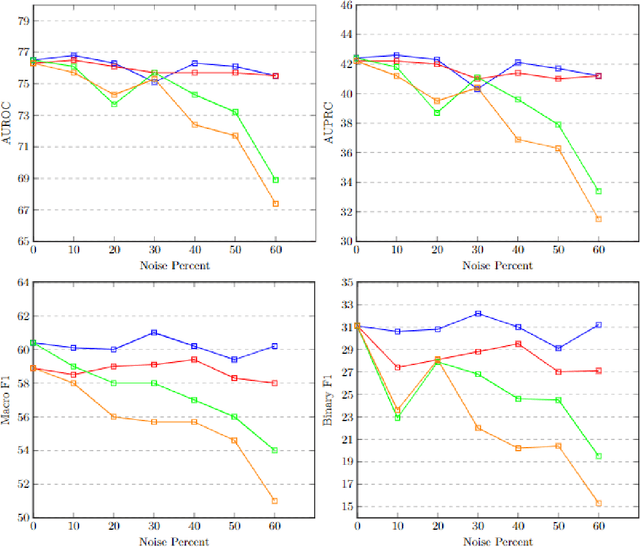
Abstract:With the increasing availability of diverse data types, particularly images and time series data from medical experiments, there is a growing demand for techniques designed to combine various modalities of data effectively. Our motivation comes from the important areas of predicting mortality and phenotyping where using different modalities of data could significantly improve our ability to predict. To tackle this challenge, we introduce a new method that uses two separate encoders, one for each type of data, allowing the model to understand complex patterns in both visual and time-based information. Apart from the technical challenges, our goal is to make the predictive model more robust in noisy conditions and perform better than current methods. We also deal with imbalanced datasets and use an uncertainty loss function, yielding improved results while simultaneously providing a principled means of modeling uncertainty. Additionally, we include attention mechanisms to fuse different modalities, allowing the model to focus on what's important for each task. We tested our approach using the comprehensive multimodal MIMIC dataset, combining MIMIC-IV and MIMIC-CXR datasets. Our experiments show that our method is effective in improving multimodal deep learning for clinical applications. The code will be made available online.
TIGQA:An Expert Annotated Question Answering Dataset in Tigrinya
Apr 26, 2024Abstract:The absence of explicitly tailored, accessible annotated datasets for educational purposes presents a notable obstacle for NLP tasks in languages with limited resources.This study initially explores the feasibility of using machine translation (MT) to convert an existing dataset into a Tigrinya dataset in SQuAD format. As a result, we present TIGQA, an expert annotated educational dataset consisting of 2.68K question-answer pairs covering 122 diverse topics such as climate, water, and traffic. These pairs are from 537 context paragraphs in publicly accessible Tigrinya and Biology books. Through comprehensive analyses, we demonstrate that the TIGQA dataset requires skills beyond simple word matching, requiring both single-sentence and multiple-sentence inference abilities. We conduct experiments using state-of-the art MRC methods, marking the first exploration of such models on TIGQA. Additionally, we estimate human performance on the dataset and juxtapose it with the results obtained from pretrained models.The notable disparities between human performance and best model performance underscore the potential for further enhancements to TIGQA through continued research. Our dataset is freely accessible via the provided link to encourage the research community to address the challenges in the Tigrinya MRC.
* 9 pages,3 figures, 7 tables,2 listings
Beyond Accuracy: Investigating Error Types in GPT-4 Responses to USMLE Questions
Apr 20, 2024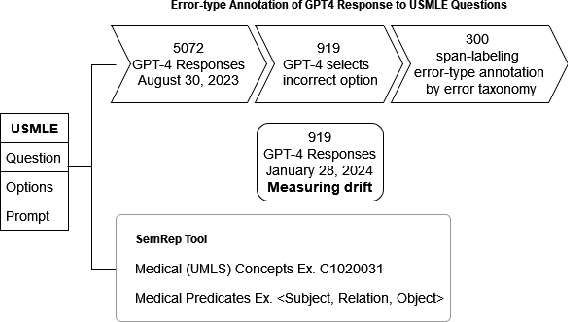
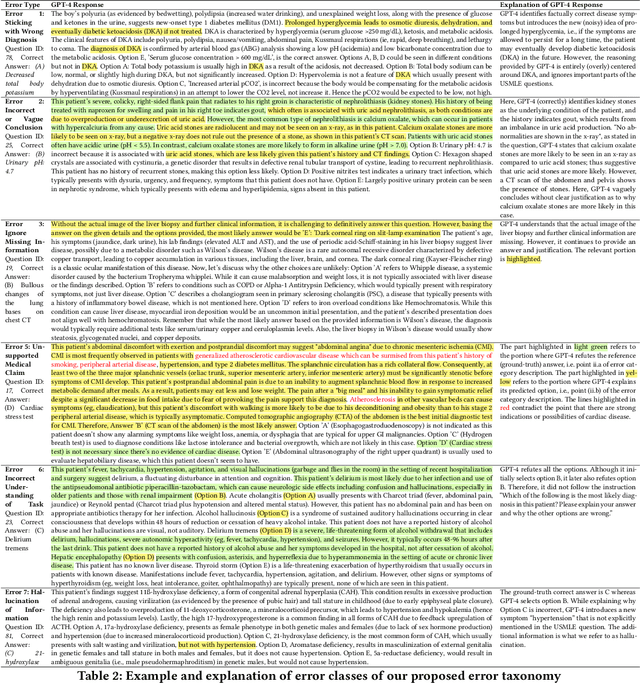
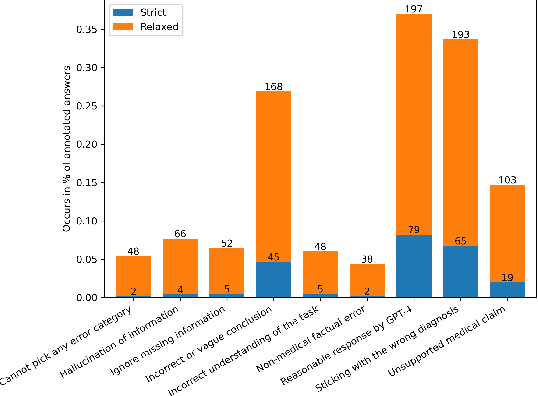
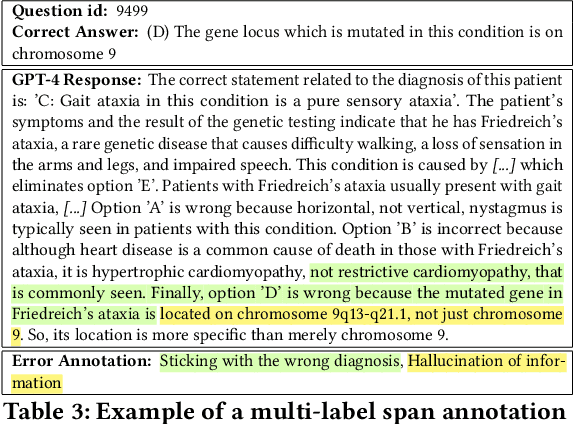
Abstract:GPT-4 demonstrates high accuracy in medical QA tasks, leading with an accuracy of 86.70%, followed by Med-PaLM 2 at 86.50%. However, around 14% of errors remain. Additionally, current works use GPT-4 to only predict the correct option without providing any explanation and thus do not provide any insight into the thinking process and reasoning used by GPT-4 or other LLMs. Therefore, we introduce a new domain-specific error taxonomy derived from collaboration with medical students. Our GPT-4 USMLE Error (G4UE) dataset comprises 4153 GPT-4 correct responses and 919 incorrect responses to the United States Medical Licensing Examination (USMLE) respectively. These responses are quite long (258 words on average), containing detailed explanations from GPT-4 justifying the selected option. We then launch a large-scale annotation study using the Potato annotation platform and recruit 44 medical experts through Prolific, a well-known crowdsourcing platform. We annotated 300 out of these 919 incorrect data points at a granular level for different classes and created a multi-label span to identify the reasons behind the error. In our annotated dataset, a substantial portion of GPT-4's incorrect responses is categorized as a "Reasonable response by GPT-4," by annotators. This sheds light on the challenge of discerning explanations that may lead to incorrect options, even among trained medical professionals. We also provide medical concepts and medical semantic predications extracted using the SemRep tool for every data point. We believe that it will aid in evaluating the ability of LLMs to answer complex medical questions. We make the resources available at https://github.com/roysoumya/usmle-gpt4-error-taxonomy .
ECOR: Explainable CLIP for Object Recognition
Apr 19, 2024
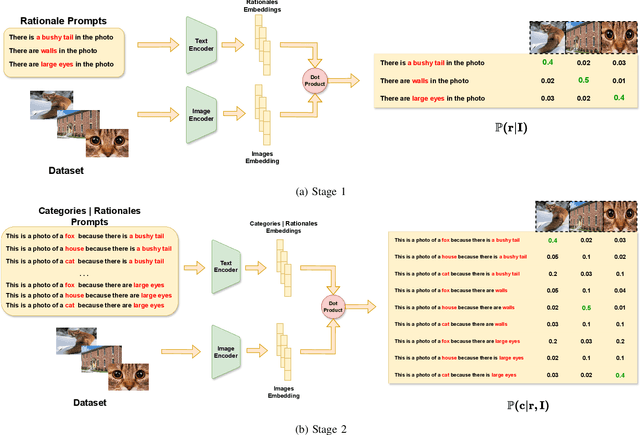
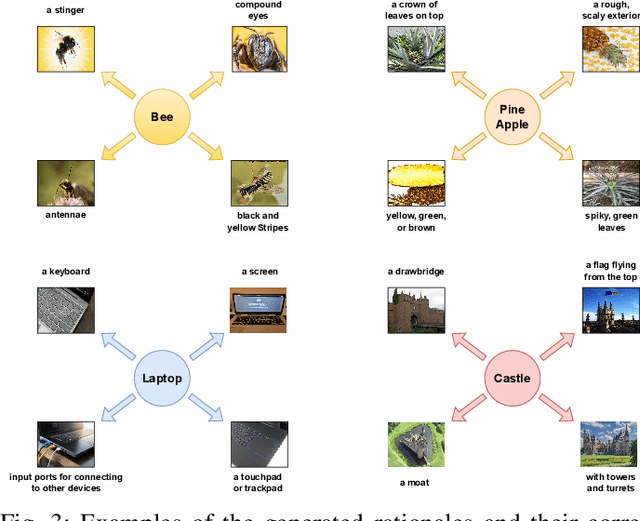
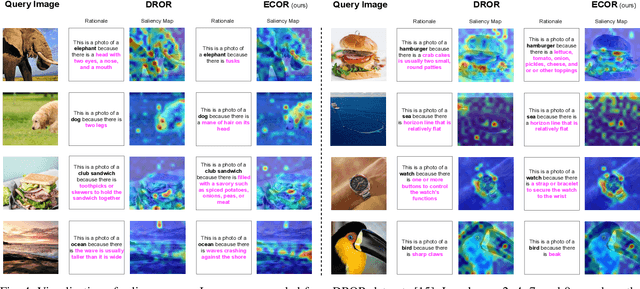
Abstract:Large Vision Language Models (VLMs), such as CLIP, have significantly contributed to various computer vision tasks, including object recognition and object detection. Their open vocabulary feature enhances their value. However, their black-box nature and lack of explainability in predictions make them less trustworthy in critical domains. Recently, some work has been done to force VLMs to provide reasonable rationales for object recognition, but this often comes at the expense of classification accuracy. In this paper, we first propose a mathematical definition of explainability in the object recognition task based on the joint probability distribution of categories and rationales, then leverage this definition to fine-tune CLIP in an explainable manner. Through evaluations of different datasets, our method demonstrates state-of-the-art performance in explainable classification. Notably, it excels in zero-shot settings, showcasing its adaptability. This advancement improves explainable object recognition, enhancing trust across diverse applications. The code will be made available online upon publication.
 Add to Chrome
Add to Chrome Add to Firefox
Add to Firefox Add to Edge
Add to Edge